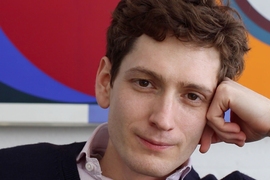Today’s protests in Iran have been cited as the biggest threat the Islamic Republic has faced since it seized power in 1979. Ignited over the regime’s mandatory veiling of women and the recent death of Mahsa Amini while in morality police custody, the uprising is rooted in the Iranian people’s long struggle for freedom, says Pouya Alimagham, a historian of the modern Middle East.
In his research, Alimagham, an expert on Iran, Iraq, and the Levant, explores such themes as revolutionary and guerrilla movements, imperialism, “Political Islam,” and post-Islamism. His book, “Contesting the Iranian Revolution: The Green Uprisings” (Cambridge University Press, 2020), explores the political movement that contested the 2009 presidential election of Mahmoud Ahmadinejad, and how it challenged the regime’s legitimacy to its very core.
In this interview, Alimagham, discusses the historical context behind the current movement, compares it with other uprisings in Iran, and explains what this could mean for the country’s future.
Q: Is the current protest movement the biggest threat the Iran regime has faced since seizing power in 1979?
A: I have read the current protest movement described as the biggest challenge since the clergy seized power in 1979 after the Iranian Revolution, as well as the biggest challenge since the Green Movement protests in 2009, when an uprising erupted after widespread allegations of election fraud in which the state declared its preferred candidate and incumbent, Mahmoud Ahmadinejad, as the “winner.”
In sheer numbers, the Green Movement was far bigger. On just one day, June 15, 2009, 3 million people gathered in Tehran to protest the state — this sum does not include protests across the country on the same day. We have yet to see protests of that magnitude in the uprising today. What is markedly different between 2009 and now is the continuity of the protests today. The uprising in 2009 transpired every day for a full week until it was driven underground, only to resurface on specific political holidays to renew the struggle. Iran has holidays programmed into its political calendar in which the state encourages people, typically its supporters, to come out and walk in step with the government to mark specific occasions. One such example is the National Day Against Global Arrogance, which marks the seizure of the U.S. embassy in Iran on Nov. 4, 1979. When the Green Movement was temporarily suppressed and was unable to organize protests on a daily basis, it would use the cover of such political holidays to emerge and reignite the protest movement. It carried on in such a manner for months, until Feb. 11, 2010 — one continuous week-long uprising morphed into several spread out on Iran’s calendar.
Today’s uprising, while smaller at the moment, has been a continuous, daily movement — despite the government’s best attempts to violently put it down. As of now, the death toll is about four times higher than the casualty rate of the Green Movement, which was larger and longer but more sporadic.
Q: What sets this protest apart from other protests in Iran including the Green Movement, which is the topic of your book?
A: There are important similarities and differences. For one, both started over an issue and immediately morphed into something much bigger. In 2009, the protests were initially about the election results, but quickly began to target the entire state that ratified the election results — the initial slogan of “Where is my vote?” in June 2009 gave way to “This month is the month of blood, Sayyid Ali [Khamenei] will be toppled” by December of the same year.
Today’s protests started over the mandatory veiling of women and the death of Mahsa Amini in morality police custody, and likewise became about much more, such as targeting the entire state for enforcing such draconian policies.
Both movements had women martyr figures. The Green Movement had Neda Agha Soltan, whose death was captured on camera on June 20, 2009, and became one of the most televised deaths in history, and today’s uprising has Mahsa Amini. A key difference is that while gender and political issues were also very important to 2009, gender issues have risen to be on par with political issues, and women and girls are at the very forefront of the uprising. That is, the slogan for the protests today is tellingly, “Women, Life, Freedom.”
I think there is also an important continuity between the two moments. Analysts often refer to the Green Movement as a “failure” for failing to abrogate Ahmadinejad’s election “win” or failing to overthrow the state that ratified the election results, but there were other important successes. One such success is that the Green Movement both shattered the political taboo of challenging the cornerstone of the Islamic Republic state, the Rule of the Jurisprudent, and broke up the state’s monopoly over its Islamic and revolutionary symbols of legitimation. In that vein, the Green Movement started by contesting the election results, then it contested the sources of the state’s legitimacy. In doing so, it undermined the state’s ideological foundations. The movement ended with a total negation of the state. Every protest movement since 2009 has picked up where the Green Movement was put down — targeting the state as a whole. In that vein, one of the slogans of today’s uprising is a modification of a Green Movement rally cry, “This year is the year of blood, Sayyid Ali [Khamenei] will be toppled.”
Q: How is the regime responding, and what does this tell us about the future of the regime?
A: The regime has doubled down with repression, as it did when activists challenged it in 2009, 2017-2018, and today. It sees compromise as showing weakness. It has such a perception because of the history of the Iranian Revolution, through which this government was born. In the revolution, the Shah dithered between compromise and heavy-handedness. Often employing both approaches at once. For instance, the Shah amnestied political prisoners, which gave momentum to the revolution as activists interpreted the amnesty as proof that they could net political results if they continued on their trajectory. At the same time, the Shah implemented a military government and martial law, which prompted further revolutionary ire and a new target for mobilization.
The Iranian state today, on the other hand, knows this history and has never compromised in the face of protesters. In 2009, it affirmed the election results and cracked down on demonstrations. In November 2019, when it removed a gasoline subsidy that sparked protests, it did not backtrack and killed scores. Today, it likewise has sought a security solution to protesters instead of a political one. That is not to say that compromise is impossible, it just means that given this history, it is not likely. It is worth mentioning that however unlikely it is for the government to compromise, it may very well be too late even if it does. Iranians have been reeling under the heavy boot of the government’s authoritarianism for too long and may not accept such compromise, even if it was forthcoming.
Q: Finally, can you briefly provide a historical context for today’s protests in Iran?
A: Today’s struggle is part of a long genealogy of revolutions in which generations of Iranians have sought a more representative, democratic, accountable, equitable, just, and humane government.
Previous moments in Iranian history have been aborted, such as when Imperial Britain and Tzarist Russia intervened during Iran’s Constitutional Revolution more than a hundred years ago, or when the CIA-MI-6 overthrew the democratic-elected government of Dr. Mohammad Mossadeq, Iran’s first true experiment with democracy, in 1953.
The Iranian Revolution of 1978-79 was about freedom and independence. It achieved the latter, but faltered miserably when it came to the former. Today’s uprising is rooted in this past as it seeks to rectify its shortcomings; Iranians continue to struggle for freedom.









